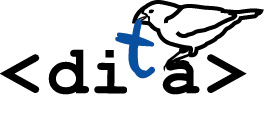
Jen Linton, the co-author of Introduction to DITA:Getting Started with the Darwin Information Typing Architecture is in Austin to teach the DITA Getting Started workshop hosted by BMC Software. I’m attending along with several of my co-workers, and we’re all learning a lot.
Last night I went to dinner with Don Day, chair of the OASIS DITA Technical Committee, Jen, and Wendy Shepperd, a manager here at BMC. Jen asked Don, “What’s the story with the bird in the DITA logo?” I had blogged earlier that it’s a finch with a specialized beak, but it turns out there’s more to the story. Don explained that it’s a woodpecker finch, one of the finches Darwin documented from the Galapagos Islands, and it’s a tool-using animal. Woodpecker finches pluck the spines from cacti or use wooden splinters to extract grubs and other bugs from holes that their beaks don’t fit for a tasty meal. That’s a fun piece of trivia. Here’s the logo to which I’m referring.
After dinner we went to the Central Texas DITA User Group meeting, where Jen told and showed us how she assembled the Introduction to DITA book using DITA topics. The most interesting part for me was to learn about the Mekon FrameMaker plug-in that lets you import DITA content into FrameMaker for book assembly and above all, index generation. Nifty! It’s part of the DITA Open Toolkit if you browse the CVS repository.
In our training class, we wondered out loud where all the local User Groups are forming currently, and I found this list at http://dita.xml.org/user-groups:
Canada
- Ontario: Toronto DITA User Group
- British Columbia: Vancouver DITA User Group
United States
- California: Silicon Valley DITA Interest Group
- Indiana: Indy DITA
- Massachusetts: Boston DITA User Group
- New York: NY Metro DITA Users Group
- North Carolina: Research Triangle Park DUG
- Texas: Central Texas DITA Users Group (Austin)
